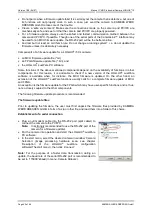
Version 1.08 (04/07)
Manual: CMOS Industrial Camera LOGLUX
i5
Page 44 of 46
KAMERA WERK DRESDEN GmbH
Choosing a lens for the LOGLUX
®
i5 CL
The camera has a standardized C mount with a flange focal length (distance from the lens mounting
flange to the active sensor surface) of 17.53mm, and an inch-system based thread 1-32UN-2A
specification).
The sensor size calls for CCTV lenses which are at least suitable for 2/3-inch sensors. In any case,
high-quality lenses featuring a low distortion, high image resolution, high-grade antireflection coating,
and good contrast ratio should be used for image processing purposes. Lenses as used in common
surveillance equipment are not suitable for industrial image processing applications.
Matching the flange focal length of a lens with the LOGLUX
®
i5 CL
Production tolerances both of the lens and the optical camera system make it necessary to fine-adjust
the flange focal length using the camera adjusting feature.
Make the adjustment at full aperture. Set the focusing ring of the lens to „
∞
“ ('infinity'). Point the
camera to a well structured, sufficiently distant subject (
≥
2000 x focal length). Make sure the lens is
properly seated on the flange of the lens mount.
First loosen the three setscrews on the circumference of the lens mount flange; for the purpose, use
the supplied small hexagonal wrench (wrench size 0.9) and turn the setscrews out by one full rotation
each. Then turn the lens with guide ring (!) out of the flange, or into the flange, until the subject is in
optimum focus. Finally, retighten the setscrews applying not too much force.
For more information, also with respect to using zoom lenses, see the website of PENTAX Europe
GmbH (
).
Frequently asked questions
Question:
What do I need the 'Advanced Features' option for?
Answer:
By means of this option, you have access to the terminal which is an integral part of the
program, and to the functions in a camera firmware update. In order to avoid unintentional
activation of the above-mentioned functions, the box is normally not checked.
Question:
What do the different framebuffer display modes mean?
Answer:
The 'Grey' option shows the eight lowermost bits (MSB) of a pixel.
Option 'Blue enhanced' shows the lowermost nine bits (MSB) of a pixel and gives the black
and white regions of a live image a green and red color, respectively. This allows an
underexposure or overexposure of the image to be easier detected.
The 'Pseudo grey' option shows 10.5-bit interpolated greyscale values (MSB) slightly
differing from the exact RGB greyscale values. Here, too, the black and white regions are
tinted green and red, respectively.
Please note that the two latter modes require more computer power and may, thus, result
in a lower image rate.
Question:
How can the 'Multiple integration slope mode' reasonably be configured?
Answer:
The best way is to start using an integration (exposure) time in such a way that - with the
integration time as low as possible - the details which are of interest can just be safely
discerned in the dark parts of the image. The time to be so determined is the total
integration time for the specific image. When using the 'Exposure precalculation' function in
the 'Exposure‘ configuration window of the active LuxWare profile, the user may adapt the
transmission function of the sensor by carrying out an approximation to an exponential or
root function. To this end, the previously determined total integration time is subdivided into
up to four partial integration times. This can also be performed manually, i.e. the user can
add up to four partial integration times to obtain the previously determined total integration
time. Reasonably, the first partial integration time should be the longest time, and the last
partial integration time should be the shortest time.



































